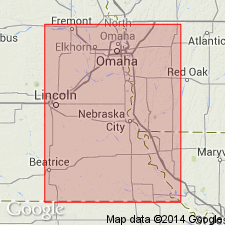
- Usage in publication:
-
- White Cloud shale bed
- Modifications:
-
- Original reference
- Dominant lithology:
-
- Shale
- AAPG geologic province:
-
- Forest City basin
Summary:
Pg. 40, 41, 58. White Cloud shale bed of Scranton shale member of Shawnee formation. Is here named from exposures west of White Cloud, [Doniphan County], eastern Kansas, where it is 100+ feet thick. It underlies Rulo limestone and overlies Howard limestone. The salmon-colored limestone in White Cloud shale, about 26 feet below overlying Rulo limestone, is here called Happy Hollow limestone, from exposures in bluffs at mouth of Happy Hollow Creek, located below mouth of Big Nemaha River. [On p. 40 a thickness of 1 foot-9 inches is given for Happy Hollow limestone.] Present in eastern Kansas and southeastern Nebraska. Age is Late Pennsylvanian (Missouri age). Report includes cross sections, measured sections, geologic maps, stratigraphic tables.
Source: US geologic names lexicon (USGS Bull. 896, p. 2320); GNC KS-NE Pennsylvanian Corr. Chart, sheet 1, Oct. 1936; supplemental information from GNU records (USGS DDS-6; Denver GNULEX).

- Usage in publication:
-
- White Cloud shale bed
- Modifications:
-
- Revised
- AAPG geologic province:
-
- Nemaha anticline
Summary:
Pg. 53. The Nebraska Geol. Survey now restricts White Cloud shale to that part of Scranton shale below Happy Hollow limestone, and applies Cedar Vale shale to beds above Happy Hollow limestone and below Rulo limestone. Age is Pennsylvanian.
Source: US geologic names lexicon (USGS Bull. 896, p. 2320); GNC KS-NE Pennsylvanian Corr. Chart, sheet 1, Oct. 1936.

- Usage in publication:
-
- White Cloud shale member*
- Modifications:
-
- Revised
Summary:
Pg. 2274 (fig. 1), 2277. White Cloud shale member of Scranton shale. Rank reduced to member of Scranton shale here reintroduced as formation with stratigraphic span as assigned to it by Haworth and Bennett (1908). Underlies Happy Hollow limestone member; overlies Howard limestone [Utopia member]. Age is Late Pennsylvanian (Virgilian).
Source: US geologic names lexicon (USGS Bull. 1200, p. 4204-4205).
For more information, please contact Nancy Stamm, Geologic Names Committee Secretary.
Asterisk (*) indicates published by U.S. Geological Survey authors.
"No current usage" (†) implies that a name has been abandoned or has fallen into disuse. Former usage and, if known, replacement name given in parentheses ( ).
Slash (/) indicates name conflicts with nomenclatural guidelines (CSN, 1933; ACSN, 1961, 1970; NACSN, 1983, 2005, 2021). May be explained within brackets ([ ]).

